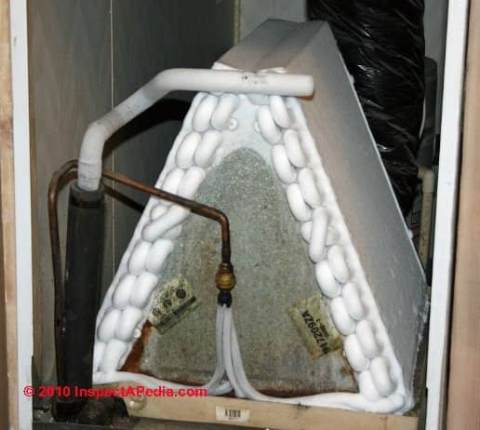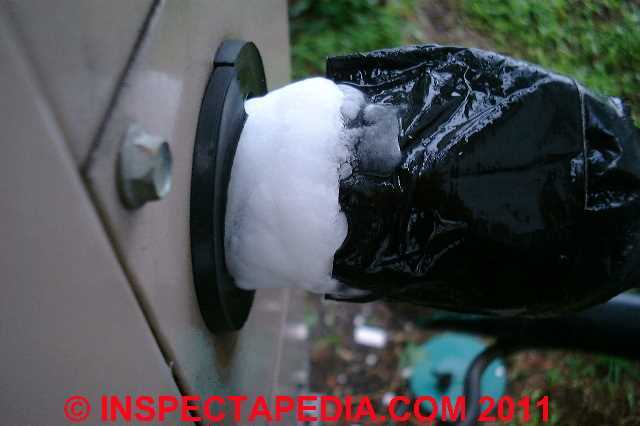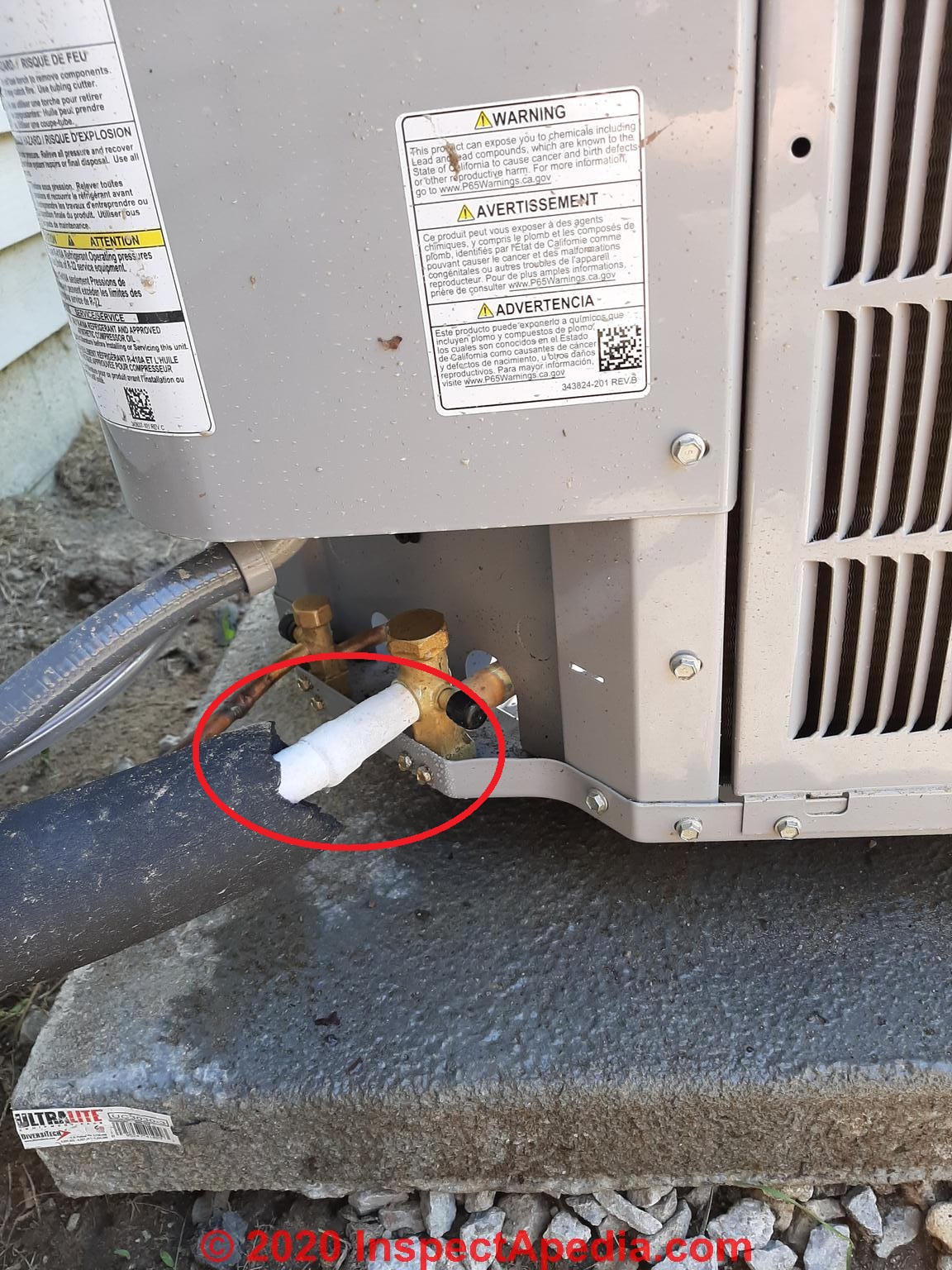 Refrigerant Piping Ice or Frost Diagnosis & Repair
Refrigerant Piping Ice or Frost Diagnosis & Repair
at Air Conditioners or Heat Pumps
- POST a QUESTION or COMMENT about the causes, effects, and cures of icing or frost formation on the air conditioner or heat pump cooling coil
Refrigerant piping or suction line ice & frost formation diagnosis & cure: refrigerant line frost cause & remedy.
This air conditioning repair article series discusses evaporator coil icing: the problems of ice and frost formation in air conditioning system air handler units, blower units, or AHU's, duct work, or other air conditioning system components.
A freezing or frosted A/C coil blocks air flow and leads to loss of cooling.
The air conditioning system evaporator coil and problems of frost build-up on the air conditioning coil are explained and diagnosed here.
Our page top photograph of a thoroughly ice-blocked air conditioner evaporator coil was contributed by a reader who described: "I cleaned the coils & installed a new filter - obviously I have a low refrigerant problem. This is an 11 year old furnace/air handler with no history of other problems, but low on Freon."
InspectAPedia tolerates no conflicts of interest. We have no relationship with advertisers, products, or services discussed at this website.
- Daniel Friedman, Publisher/Editor/Author - See WHO ARE WE?
Why Frost or Ice May Appear on an Air Conditioning Refrigerant Suction Line
This article focuses on causes & cures of/for ice or frost formation on refrigeration piping. Here we describe teh locations and causes of condensate, frost or ice formation in air conditioning / heat pump systems, air handlers, compressor/condensers, refrigerant lines, and in air ducts.
Several reasons can cause frost or ice formation not only on the indoor evaporator or cooling coil, but also on the refrigerant suction lines at the equipment as well.
Where Will Ice or Frost Show Up on Refrigerant Piping?
The ice shown in our photo just above is on the refrigerant SUCTION LINE at the outdoor compressor / condenser unit for an air conditioner or heat pump system.
Similar ice may form at the indoor air conditioner or heat pump at the indoor evaporator coil (also called the COOLING COIL) at other end of the air conditioning system, as you can see in our iced-up air conditioning cooling coil photograph at the top of this page.
Frost and ice can even form inside air conditioning DUCTWORK, leading to troublesome leaks into the building.
When a heat pump is operating in heating mode, you might also see frost on the smaller diameter refrigerant line since the flow of refrigerant is reversed in the system in heat mode.
Causes & Remedies for Ice or Frost on Air Conditioners or Heat Pumps
- Iced or Frosted Indoor Evaporator Coil / Cooling Coil caused by Blocked Air Flow or bad TEV
If there is blocked or weak air flow across the cooling coil, for example from a dirty air filter, collapsed duct insulation, crimped flex-duct, or similar problem the coil isn't being warmed by building air and frost may form on the coil, leading to almost complete blockage of air flow. You might notice this as weak air flow at air supply registers.
If, however there is good air flow across the evaporator coil and the coil is clean, then the system may be over-charged (too much refrigerant) or more often, we suspect a bad refrigerant metering device that is sending too much refrigerant into the evaporator coil.
In HVACR school one of the first refrigerant charge lessons we learned was to look for frost at the entry to the evaporator coil and to stop adding refrigerant then. If we saw frosting further along the evaporator (cooling) coil then we were over-charging the system. - Ice or Frosted Outdoor Refrigerant Tubing caused by Too-Low Refrigerant Charge Level
Improper refrigerant charge (too low a charge of refrigerant in the A/C system can, for a while, lead to too-low temperatures in the coil which will then cause frost or ice build-up on the suction line.
Ultimately however, when there is simply little or no refrigerant left in the cooling system, temperature at the cooling coil will climb back up, the frost will disappear, and you'll no longer have any cooling at all.
In air conditioning service schools the instructor may demonstrate this effect by dynamically adjusting the amount of refrigerant in the cooling system as students watch the frost line extend down the suction line, then crawl back up to near the end of the cooling coil as the proper refrigerant charge amount is reached.
Alternatively, on some cooling systems too much refrigerant can cause liquid refrigerant to flow past the cooling coil into the suction line,also causing icing. - Ice or Frosted Outdoor Refrigerant Tubing caused by faulty refrigerant metering device, Thermostatic Expansion Valve or Cap Tube:
a malfunctioning refrigerant metering device like a bad thermal expansion valve (TEV).
Conversely, a bad capillary tube (a more rudimentary refrigerant metering device found on refrigerators, dehumidifiers, and window air conditioners) won't fail by passing too much refrigerant but it might fail by passing too little refrigerant or failing to pass any refrigerant at all if it becomes blocked by debris or by a slug of oil in the system. - Ice on the Compressor Motor or on Refrigerant Piping Close to the Compressor caused by a faulty defrost control:
A malfunctioning auto-defrost control or bad defrost timer control (less common on residential air conditioning systems) - Ice or Frost on the Cold Suction Line If the Air Conditioner or Heat Pump Economimzer Piping Bond has Broken:
If the bond is broken between the hot high pressure refrigerant line and the cold suction line allowing piping sections of an economizer to separate, leaving frost on the suction line.
( You won't find this bonding on all HVACR equipment.)
OK so what's an "Economizer"?
In some air conditioners or heat pumps at the point where the low-side suction line enters the compressor condenser unit the low-temperature (heat laden) vapor line (suction line) is soldered or brazed right next to and touching the high-temperature, high-pressure liquid refrigerant line.
The purpose of this refrigerant piping detail is to act as a heat exchanger, to reduce the temperature of the liquid refrigerant that is going to enter the metering device (TEV or cap tube), gaining some benefit to system operation.
- Gurgling heard in refrigerant piping caused by insufficient refrigerant charge
If you hear gurgling in the refrigerant piping lines it's possible that the system is under-charged or has lost refrigerant due to a leak. - Bubbles seen in a sight glass on the regrigerant line, caused by low refrigerant
If your refrigerant piping includes a sight glass and you see bubbles passing by t's possible that the system is under-charged or has lost refrigerant due to a leak.
See REFRIGERANT SIGHT GLASS
Examples of Ice Formation on Refrigerant Lines at the Outdoor Compressor/Condenser Unit
Below we've circled in red a coating of white frost on the suction line returning to an outdoor condenser unit.
Photo above courtesy of InspectApedia reader Ryan who wrote: Help we have a brand new AC freezing up on the outside pipes. They've been out 4 times and cant figure it out. Already replaced TEV valve.
We suggested first checking that the refrigerant charge is correct. That may require evacuating the system and then re-charging its refrigerant with the quantity specified by the manufacturer for that model.
If the Evaporator coil and suction line keep freezing up: Suspect the Thermostatic Expansion Valve
An InspectApedia reader wrote: I have a 2005 Duroguard A/C hooked up to an old GE gas furnace. The evaporator and suction line freeze up constantly. Tech checked high side pressure only, it was good.
Furnace blower motor, capacitor and filter were replaced and the unit still freezes. The thermostat works normally.
I am beginning to suspect a bad TEV or cap tube. Does that sound like the problem? - Chuck 7/8/11
Our Reply:
Indeed if the refrigerant charge is correct and airflow across the coil is good but icing is still occurring, I'd suspect a bad TEV. (Thermostatic expansion valve).
Some TEVs are adjustable so yours could need adjustment.
And a TEV can be clogged or blocked by dirt, debris, or ice.
...
...
Continue reading at UNDER CHARGED REFRIGERANT, EFFECTS or select a topic from the closely-related articles below, or see the complete ARTICLE INDEX.
Or see REFRIGERANT LINE FROST FAQs - questions & answers about frost formation on refrigeration piping, posted originally at this page
Or see these
Recommended Articles
- COOLING COIL or EVAPORATOR COIL
- DIAGNOSTIC GUIDE A/C or HEAT PUMP
- DIAGNOSTIC DETAILS A/C or HEAT PUMP
- FROST BUILD-UP on AIR CONDITIONER COILS
- OVER CHARGED of REFRIGERANT, EFFECTS
- REFRIGERANT GASES & PIPING
- REFRIGERANT LEAK REPAIR
- REFRIGERANT PRESSURE DIAGNOSIS
- AIR CONDITIONING & HEAT PUMP SYSTEMS
Suggested citation for this web page
REFRIGERANT LINE FROST at InspectApedia.com - online encyclopedia of building & environmental inspection, testing, diagnosis, repair, & problem prevention advice.
Or see this
INDEX to RELATED ARTICLES: ARTICLE INDEX to AIR CONDITIONING & HEAT PUMPS
Or use the SEARCH BOX found below to Ask a Question or Search InspectApedia
Ask a Question or Search InspectApedia
Try the search box just below, or if you prefer, post a question or comment in the Comments box below and we will respond promptly.
Search the InspectApedia website
Note: appearance of your Comment below may be delayed: if your comment contains an image, photograph, web link, or text that looks to the software as if it might be a web link, your posting will appear after it has been approved by a moderator. Apologies for the delay.
Only one image can be added per comment but you can post as many comments, and therefore images, as you like.
You will not receive a notification when a response to your question has been posted.
Please bookmark this page to make it easy for you to check back for our response.
IF above you see "Comment Form is loading comments..." then COMMENT BOX - countable.ca / bawkbox.com IS NOT WORKING.
In any case you are welcome to send an email directly to us at InspectApedia.com at editor@inspectApedia.com
We'll reply to you directly. Please help us help you by noting, in your email, the URL of the InspectApedia page where you wanted to comment.
Citations & References
In addition to any citations in the article above, a full list is available on request.
- Modern Refrigeration and Air Conditioning, A. D. Althouse, C.H. Turnquist, A. Bracciano, Goodheart-Willcox Co., 1982
- Principles of Refrigeration, R. Warren Marsh, C. Thomas Olivo, Delmar Publishers, 1979
- Refrigeration and Air Conditioning Technology, 5th Ed., William C. Whitman, William M. Johnson, John Tomczyk, Cengage Learning, 2005, ISBN 1401837654, 9781401837655 1324 pages
- Thanks to inspector Bill McNeill for providing a photograph of an ice-blocked evaporator coil or cooling coil in an air conditioning air handler unit. Mr. McNeill can be reached at wem007@hotmail.com
- Thanks to reader [Anonymous] for providing a photo of a totally blocked cooling coil on an 11-year-old system that was low on refrigerant. August 2010.
- Thanks to reader Tom Balla for suggesting clarification on ice formation on the air conditioning system suction line.
- Thanks to reader R. Hansen for adding air conditioning / heat pump control board failure tip that explains another cause of cooling coil or system icing. Email: rhansen79@yahoo.com July 2012
- Complete List of Air Conditioning & Heat Pump Design, Inspection, Repair Books at the InspectAPedia Bookstore.
- In addition to citations & references found in this article, see the research citations given at the end of the related articles found at our suggested
CONTINUE READING or RECOMMENDED ARTICLES.
- Carson, Dunlop & Associates Ltd., 120 Carlton Street Suite 407, Toronto ON M5A 4K2. Tel: (416) 964-9415 1-800-268-7070 Email: info@carsondunlop.com. Alan Carson is a past president of ASHI, the American Society of Home Inspectors.
Thanks to Alan Carson and Bob Dunlop, for permission for InspectAPedia to use text excerpts from The HOME REFERENCE BOOK - the Encyclopedia of Homes and to use illustrations from The ILLUSTRATED HOME .
Carson Dunlop Associates provides extensive home inspection education and report writing material. In gratitude we provide links to tsome Carson Dunlop Associates products and services.



